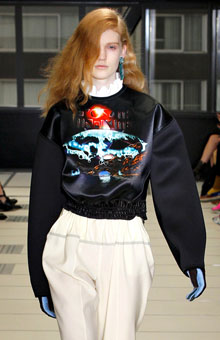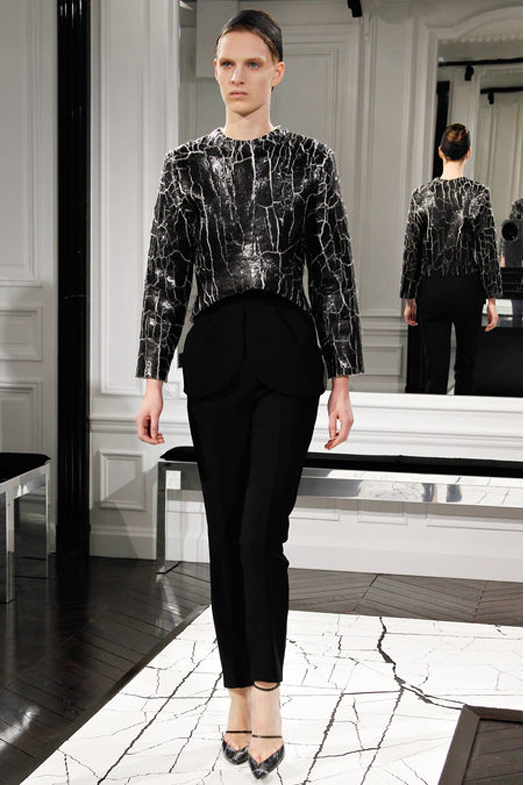Alexander Wang presented his much awaited début collection for the house of Balenciaga during the Paris a/w fashion weeks this March. Given that he only had four months to familiarise himself with the house codes and conventions after he was appointed in late November 2012, one cannot expect him to travel too far from the heavy past of the house. He expectedly returned to the origins of the house, offering his take on recognisable Balenciaga couture propositions and fabrications adding his personal vocabulary of black, white and grey. During the course of 10 or so minutes that the show lasted, the Balenciaga woman lost her avant-garde but gained a new youthful and street-referenced appearance associated with the Wang signature.
Before Alexander Wang, Nicolas Ghesquière established a solid body of work during the 15 years he served as the creative director for this legendary house. Look back at Ghesquière’ first collections in the late 90’s and you see a stark difference to his more recent collections. His early collections were modestly demure and they lacked the broadness of innovation he added to the house vocabulary as his confidence grew. He cultivated certain codes that were already signature to the house such as use of volume, proportions and some reference points like Cristobal Balenciaga love of his home country Spain, but also added his own elements that we have come to understand as part of Balenciaga vocabulary such as futuristic inspirations and real innovation in the use of materials. The closer he got to the house over the years, the more assertive his collections became.
Though Balenciaga has a lucrative handbag business particularly with the City Motorcycle style launched in 2003, the house has never been associated with commerciality. Ghesquière’s catwalks were triumph for innovation and experimentation, his vision was new and daring. Mass market success was gained when he created pieces that had the right balance of the new with the understandable such as the neoprene college shirts with space placement prints evocative of 80’s band t-shirt motifs from a/w 2012 collection.[ref]
 Source: Style.com [/ref] It is interesting now to read about Ghesquière’s decision to leave the house as details of this are emerging with his first interviews with System[ref]System[/ref], a new fashion industry magazine and 032C[ref]032C[/ref], German contemporary culture publication. Lack of solid relationship with the business side of the brand seems to have contributed to Ghesquière’s departure as he reflected on the success of brands such as Prada and Chanel, both, which have a clear commerce and creative direction.
Source: Style.com [/ref] It is interesting now to read about Ghesquière’s decision to leave the house as details of this are emerging with his first interviews with System[ref]System[/ref], a new fashion industry magazine and 032C[ref]032C[/ref], German contemporary culture publication. Lack of solid relationship with the business side of the brand seems to have contributed to Ghesquière’s departure as he reflected on the success of brands such as Prada and Chanel, both, which have a clear commerce and creative direction.
‘I never had a (business) partner, and I ended up feeling too alone. I had a marvelous studio and design team who were close to me, but it started becoming a bureaucracy and gradually became more corporate, until it was no longer even linked to fashion. In the end, it felt as though they just wanted to be like any other house.'[ref]BoF Exclusive | Nicolas Ghesquière Finally Speaks On Why He Left Balenciaga, by Johanthan Wingfield, Published: April 28, 2013[/ref]
Leaving at the height of his career at Balanciaga, Ghesquière probably achieved everything he could have at the house, leaving gaps in commercial areas but an outstanding body of work in terms of fashion design. In contrast, the decision to hire Alexander Wang was a curious one and much debated in the industry. Known for his clever business vision where t-shirt sales seem to have really made the financial foundation of the house and for his ability to create both garment and accessories adored by the new fashion girls that have a real mass market appeal, he’s job appears to be to bridge a gap.
And it is that commercial and creative gap that Alexander Wang started to fill with his first show that was all about cracked surfaces. Take for instance look 30, a simple two part outfit that reads commerciality but has nuances of Balenciaga. A skinny matt trousers finishing just above the ankle has a subtly sculptural feel created by the peplum which only really works for model sizes. The proportions of the top is interesting in that it combines elements in the shape that can be understood through the knowledge of both Cristobal Balenciaga’s and Alexander Wang’s work. It is cropped suggesting the young reference points of Wang, but has the shapely quality and slightly shortened sleeve length synonymous with the original Balenciaga and his obsessions with exposed wrists. The material that looks like leather, communicates the street qualities synonymous to Wang, but the actual fabrication, which in fact is white knit coated with black paint, conforms to the fabric innovation perfected by Ghesquière during his time at the house. The cracked surface effect, which in other parts of the collection was interpreted as prints, fur treatments even as part of the show set, is effective due to the way in which the flexibility of the knit and solidness of the paint interact with each other. The ensemble IS commercial but has enough design interest to merit it to be understood as part of the house style.
Getting up close and personal has its advantages in developing an in depth understanding of a product or a brand but spaces in between and a critical distance of a newcomer also has it’s advantages. Like a snake, fashion periodically sheds its skin to expose new layers. New guard of designers has been given an opportunity to re-interpret the established codes of famous houses such as Kenzo, Balenciaga and Dior. For some designers, the transition is smooth, even triumphant like with Raf Simons at Christian Dior, with others it is a struggle: it took years for Ricardo Tisci to establish himself as a designer at Givenchy. The fashion industry responded positively to Alexander Wang’s first collection but it wasn’t surprising or innovative, but neither was Ghesquière’s first show. Alexander Wang very subtly cracked the surface, but whether he can go deeper, remains to be seen.



